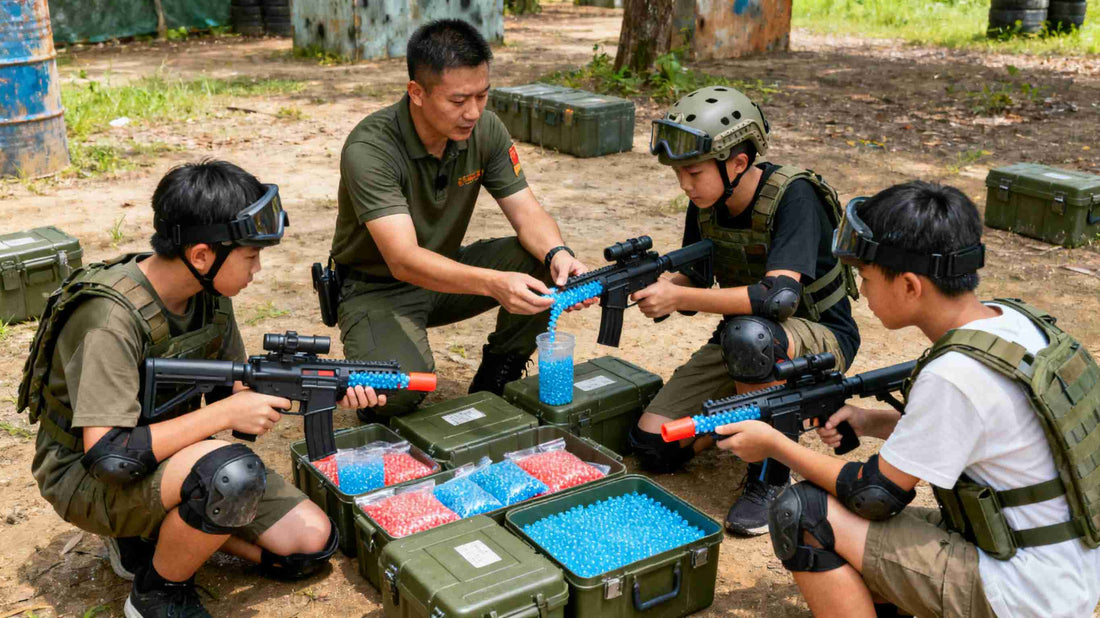
How do you know when gel bullets are done?
Share
If you’ve ever stared at a bowl of soaking gel bullets, wondering “Is this enough?” or “Did I stop too soon?”, you’re not alone. For gel blaster players—especially beginners—knowing when gel bullets are “done” (fully soaked and ready to use) is one of the most frustrating parts of prep. Soaking time helps, but it’s not foolproof: a 3-hour soak might work for one brand, but leave another with hard, unuseable cores.
The truth is, “done” isn’t just about time—it’s about how the bullets feel, look, and perform. A fully soaked gel bullet has no dry spots, holds its shape, and balances flexibility with firmness—critical for safe, jam-free play. This guide breaks down the science behind “done” gel bullets, shares 5 actionable ways to test them, and fixes the myths that make players waste ammo or damage their blasters.
1. First: Why “Knowing When Done” Matters (It’s Not Just Fussiness)
Before diving into tests, let’s clarify why getting “done” right is non-negotiable. Gel bullets are made of superabsorbent polymer (SAP), which needs to absorb water evenly to form a stable hydrogel (95% water, 5% polymer). A bullet that’s “not done” (under-soaked) or “over-done” (over-soaked) causes problems at every step:
Under-Soaked Bullets: Dangerous and Damaging
Under-soaked bullets have a dry, hard core—even if the outer layer looks swollen. Here’s what happens when you use them:
- Safety Risks: The hard core acts like a tiny plastic pellet. Fired at 300fps, a 7mm under-soaked bullet delivers ~1.2 joules of force—enough to bruise skin or hurt eyes (safety standards cap at 1.0 joules).
- Blaster Damage: Dry cores scratch barrels, jam feed mechanisms, and break pistons. I’ve seen a beginner’s electric blaster fail after 10 shots because they used under-soaked bullets—repair cost more than the blaster itself.
- Poor Accuracy: Uneven hydration makes bullets lopsided, so they veer off-target or break mid-air.

Over-Soaked Bullets: Useless and Messy
Over-soaked bullets turn mushy—their SAP chains stretch too far, losing structural integrity. Issues include:
- Magazine Jams: Mushy bullets stick together or tear in the feed tube, causing constant “clicking” (no fire).
- No Range: They’re too soft to hold velocity, dropping to the ground 5–10 meters from the blaster.
- Waste: Over-soaked bullets can’t be saved—you’ll throw away half your ammo.
In short: “Done” gel bullets aren’t just a “nice-to-have”—they’re the line between fun, safe play and frustration.
2. The 5 Foolproof Ways to Know When Gel Bullets Are Done
The best way to judge “done” is to combine multiple tests—no single method is perfect, but together they eliminate guesswork. Here’s how to do each, with science-backed reasoning:
Test 1: The Squeeze Test (Most Reliable for Beginners)
The squeeze test checks for dry cores—your fingers are more sensitive than a timer. Here’s how:
- Pick up a bullet between your thumb and index finger.
- Gently squeeze (like you’re testing a ripe grape) for 2–3 seconds.
- Release and observe:
- Done: The bullet feels firm but flexible—no hard, unyielding spot in the center. It bounces back slightly after squeezing, with no permanent indentation.
- Under-Soaked: You’ll feel a hard “lump” (the dry core) in the middle. The outer layer may squish, but the core stays rigid.
- Over-Soaked: The bullet mushes between your fingers, oozing water or tearing easily.
Why it works: SAP absorbs water from the outside in. A dry core means the polymer inside hasn’t fully hydrated—squeezing reveals this even if the bullet looks swollen.
Pro Tip: Test 3–5 bullets, not just one—some may soak faster than others (especially if the bowl was overcrowded).
Test 2: The Visual Check (Spot Uneven Hydration)
Your eyes can catch issues the squeeze test might miss, like lopsided swelling or dry patches. Look for these signs:
- Color: Done bullets are uniformly translucent (clear or light-colored, depending on the brand). Under-soaked bullets have a cloudy, white “ring” around the dry core—this is unhydrated SAP.
- Shape: Done bullets are smooth, round spheres. Under-soaked ones are lumpy or misshapen (the dry core pulls the hydrogel unevenly). Over-soaked ones are droopy or flattened (they can’t hold a sphere).
- Size: Compare to a target size (e.g., 7–8mm for standard bullets). Use a ruler if you’re unsure—done bullets should hit the target size with ±0.5mm error.
Example: A 9–10mm sniper bullet that’s only 8.5mm after 4 hours is under-soaked; one that’s 10.5mm and cloudy is over-soaked.
Test 3: The Float Test (Check for Uniform Density)
The float test uses physics to reveal hidden dry cores. Here’s how:
- Fill a small cup with room-temperature water (same as your soaking bowl).
- Drop 5–10 bullets into the cup.
- Observe their behavior:
- Done: Bullets sink slowly or hover just below the surface. Their density is uniform (close to water’s 1g/cm³), so they don’t plummet or float.
- Under-Soaked: Bullets sink like rocks. The dry core is denser than water, pulling the whole bullet down fast.
- Over-Soaked: Bullets float or bob at the surface. They’ve absorbed too much water, making them less dense than the cup’s water.
Science Note: This works because fully hydrated SAP has a density almost identical to water. A dry core (unhydrated SAP) is 1.3g/cm³—denser than water—so it drags the bullet down.
Test 4: The Size Measurement (Precision for Competitive Play)
For players who want zero guesswork (e.g., competitive gel blaster events), measure bullets with a caliper (digital or analog) or a small ruler. Here’s the standard:
- 7–8mm Standard Bullets: Done when they measure 7.0–8.0mm in diameter (no smaller than 6.5mm, no larger than 8.5mm).
- 9–10mm Sniper Bullets: Done at 9.0–10.0mm (no smaller than 8.5mm, no larger than 10.5mm).
Why precision matters: Blaster barrels are sized for specific bullet diameters. A 7mm barrel with 6.5mm under-soaked bullets will have air leakage (low range); a 7mm barrel with 8.5mm over-soaked bullets will jam.
Budget Hack: If you don’t have a caliper, use a standard pencil eraser (6mm wide) or a dime (17.9mm wide)—compare bullets to these to estimate size.
Test 5: The Test Fire (Final Real-World Check)
Even if other tests pass, a quick test fire ensures bullets work with your blaster. Here’s how:
- Load 3–5 bullets into your blaster’s magazine.
- Fire at a safe, soft target (cardboard box, foam pad—never a person or animal).
- Check for:
- Done: Bullets fly straight, hit the target with a soft “splat,” and don’t break mid-air. The blaster fires without clicking or jamming.
- Under-Soaked: Bullets bounce off the target (hard core) or cause the blaster to jam.
- Over-Soaked: Bullets break in the barrel (leaving gel residue) or drop to the ground 10 meters away.
Pro Tip: If test fire fails, don’t waste all your ammo—adjust the soak time (add 30 mins for under-soaked, drain and blot over-soaked) and retest.

3. How to Adjust for Variables (Size, Brand, Water)
No two gel bullets are the same—size, brand, and water conditions change how “done” looks. Here’s how to adapt your tests:
Variable 1: Bullet Size (7–8mm vs. 9–10mm)
- 7–8mm Standard Bullets: Soak faster (3–4 hours), so tests like squeeze and float work best. They’re more forgiving—±0.5mm size error won’t jam most blasters.
- 9–10mm Sniper Bullets: Soak slower (4–5 hours) and need stricter testing. Use the caliper for size (they must hit 9–10mm) and test fire twice—sniper blasters have tighter feed mechanisms, so even slightly under-soaked bullets jam.
Variable 2: Brand Differences (SAP Quality Matters)
- Premium Brands (Hdrason, Valken): Use uniform SAP, so most bullets soak evenly. The squeeze test alone is usually enough—they rarely have hidden dry cores.
- Budget Brands: SAP quality varies, so combine squeeze, float, and size tests. Budget bullets may need an extra 30 mins of soaking to ensure no dry spots.
Variable 3: Water Temperature & Quality
- Warm Water (28–32°C): Bullets soak faster (2–2.5 hours), but check for uneven swelling. Use the visual test—warm water can cause some bullets to puff up outside before the core hydrates.
- Cold Water (<10°C): Soak slower (5–6 hours), so don’t rush. The float test is critical here—cold water slows osmosis, so dry cores are common even if bullets look big.
- Hard Water (High Minerals): Add 30 mins to soak time, then use the squeeze test. Minerals bind to SAP, slowing absorption—you’ll need to ensure no dry cores.
4. Common Myths About “Done” Gel Bullets (Debunked)
Even with good tests, myths lead players astray. Let’s fix the most harmful ones:
Myth 1: “If the Soak Time Is Up, They’re Done”
Why It’s Wrong: Soak time is a guideline, not a rule. Water temp, bullet size, and brand change absorption speed. A 3-hour soak in cold water won’t hydrate bullets as much as 3 hours in warm water.
Fix: Use time as a starting point, then test—never trust a timer alone.
Myth 2: “Bigger Is Better—If They’re Oversized, They’re Done”
Why It’s Wrong: Oversized bullets (e.g., 9mm for a 7mm blaster) are over-soaked, not “extra done.” They’ll jam your blaster or break in the barrel.
Fix: Stick to your blaster’s target size—bigger isn’t better.
Myth 3: “Dry Spots Are Fine—They’ll Hydrate in the Blaster”
Why It’s Wrong: Blasters don’t hydrate bullets—they fire them. A dry core will stay hard, causing all the issues we listed (bruising, jams).
Fix: If you feel a dry spot, soak bullets for another 30 mins—don’t risk it.
Myth 4: “Over-Soaked Bullets Can Be Dried Out to Fix”
Why It’s Wrong: Over-soaked bullets have stretched SAP chains—drying them out makes them shriveled and brittle, not “done.” They’ll break mid-shot even if you re-soak them.
Fix: Discard over-soaked bullets—they’re unusable.

5. Emergency Situations: How to Judge “Done” Fast
If you’re in a hurry (e.g., friends are waiting to play), use these 2-minute checks to avoid mistakes:
- Quick Squeeze + Visual: Grab 3 bullets—squeeze for hard cores, then check for cloudiness. If no hard spots and they’re translucent, they’re good enough for casual play.
- Magazine Drop Test: Load 10 bullets into the magazine, tip it upside down. If bullets fall out one by one (no clumps), they’re not over-soaked. If they don’t rattle (no loose, under-soaked bullets), they’re ready.
Note: These are “good enough” checks—for competitive play, always do the full test suite.
6. What to Do After Confirming “Done”
Once your bullets pass the tests, don’t ruin them with bad post-prep:
- Drain Excess Water: Pour bullets into a colander and shake for 30 seconds—surface water causes jams (we covered this in our “Do you have to dry gel balls?” guide).
- Blot Gently: Use a lint-free towel to pat bullets—don’t rub (you’ll tear the hydrogel).
- Store Smart: If not using immediately, put bullets in an airtight container with 1 tbsp water and refrigerate—they stay “done” for 7–10 days.
Conclusion: “Done” Is a Feeling (and a Test)
The answer to “How do you know when gel bullets are done?” isn’t a single moment—it’s a combination of squeeze, sight, float, size, and fire. With practice, you’ll start to “feel” when bullets are right—like knowing a cake is done by tapping it.
For beginners, stick to the squeeze and float tests first—they’re easy and cover 90% of cases. As you get more experienced, add the caliper or test fire for precision. Either way, remember: It’s better to spend 2 extra minutes testing than to waste ammo or break your blaster.
Now grab your bowl of bullets, run through the tests, and get ready for smooth, safe, and fun gel blaster play—because “done” right is the first step to a great game.
